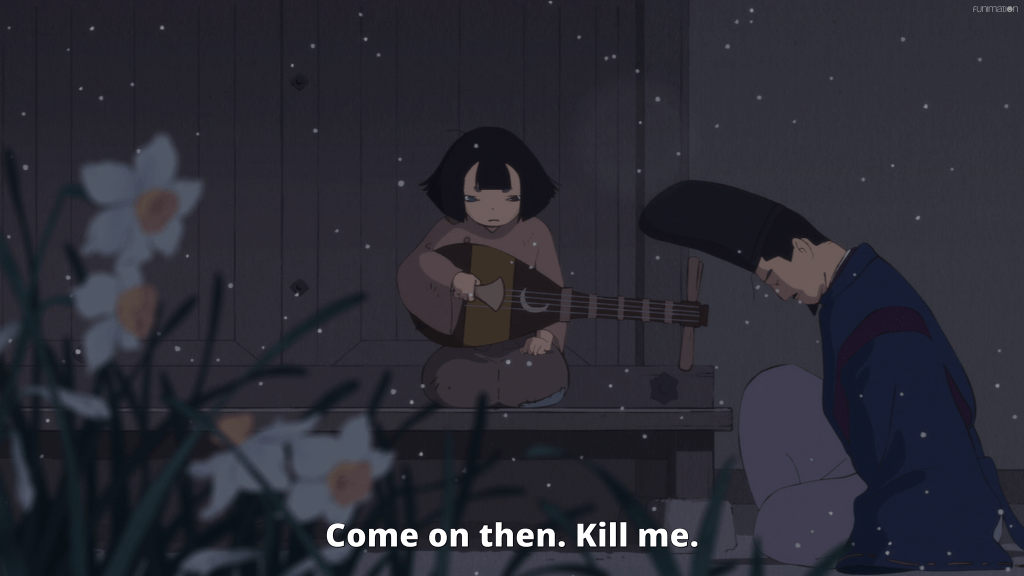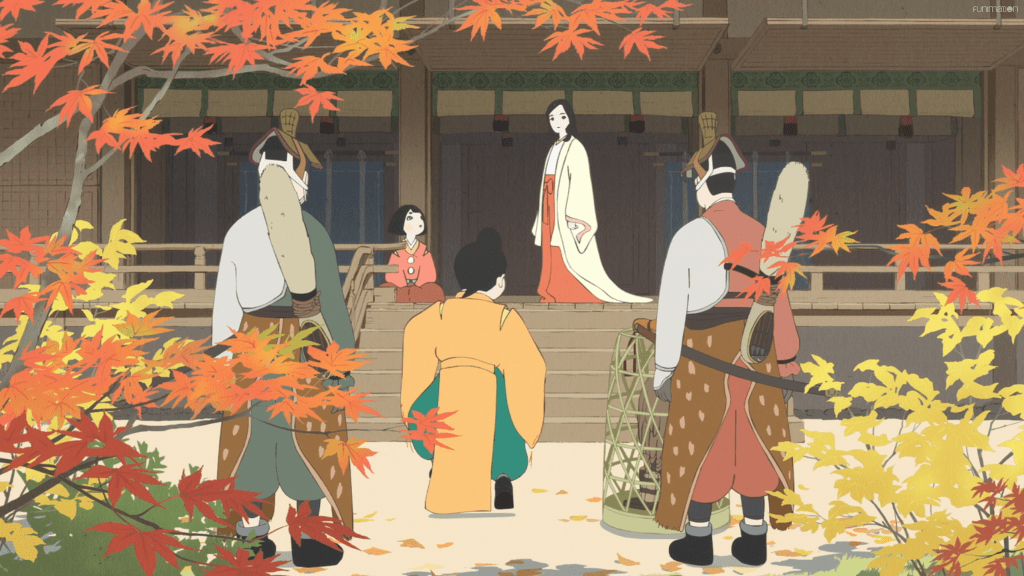The setting is medieval Japan in an era where a loose word against the local lord can cost you your life—or that of your family member, as young Biwa learns tragically in the opening moments of this episode. The child has heterochromia, a fairly common visual trope in anime, but this particular case of the condition of mismatched eye colors is not purely aesthetic, and Biwa’s struggles with her eye are far more deadly than the anxiety that Ai suffered in Wonder Egg Priority. No, when Biwa covers her naturally-colored brown eye, her pale blue right eye is filled with visions of the future, and it seems that all she ever sees is death. After wandering for an undisclosed amount of time disguised as a boy minstrel, the self-named Biwa (a name chosen after the instrument she plays) encounters a lord, Shigemori, who also possesses a special eye, though his powers of sight are weaker than hers and his eye coloring less pronounced. He is determined to win Biwa’s trust because she has seen the destruction of his clan, the Heike, and he is hoping to persuade her to help him avert their disastrous future which, although he has not seen with his own sight, he has been able to anticipate according to the unavoidable fact that all tyrants fall and his clan are becoming tyrannical. They were responsible, after all, for killing Biwa’s father. And so begins a tale of found family and family feud; of politicking and intrigue, poetry and coming of age; of special abilities and the limits of power; and potentially of the healing of one little girl’s heart.

I have so much to say about this premiere episode and all of it is very, very good. Let’s begin with the most striking feature of this episode: the cinematography. It’s not very often that cinematography stands out so startlingly in anime, but it does here, rendering what otherwise might be a throwaway opening shot of a butterfly into a poem on the profundity of stillness. Naoko Yamada (K-On, A Silent Voice, Liz and the Blue Bird) has long since been recognized for bringing a uniquely cinematographic quality to her directorial work. Indeed, she aspired to be a filmmaker before joining KyoAni as an inbetweener and sky-rocketing up the ranks to become one of, if not the, youngest female director in the industry. If you appreciate the details of camera angle, framing, deep focus, delicate character acting, lighting, and other features of filmmaking, you will enjoy this series.

The story itself is based on the Japanese medieval epic, Heike Monogatari, the tale of bloody conflict between the Taira and Minamoto clans during the Genpei War of 1180-85 that was translated recently into modern Japanese by Hideo Furukawa. The story has served as inspiration for many forms of cultural expression in Japan for centuries, including woodblock prints. I mention these because the art style of the anime strongly recalls the woodblock prints or ukiyo-e of the 17th-mid-19th centuries, the most famous of which (for a Western audience) would be Hokusai’s The Great Wave off Kanagawa. The colors are rich but with minimal shading, yet with a textured finish reminiscent of ink on thick vellum or watercolor paper that softens the shadowless kagenashi technique. The linework is clear and light, and the character designs a sort of modernized take on the stylized figures of the woodblock prints of the Edo period. Kensuke Ushio’s musical score likewise combines modern rock elements with the traditional sounds of the biwa and shamisen in an unexpected yet evocative way.

Aoi Yuuki works her usual magic with Biwa, managing to inject an already expressive, independent little girl with an extra helping of gumption and winsome grumpiness. This first episode has done a great deal to set up a range of distinct personalities and relationships that are going to be both hilarious and heart-warming to watch play out.

This has been my most most anticipated series of the season, and possibly the year (despite the Cold War level top secrecy about the project! Nary a whisper of its existence until just a couple of weeks ago!), and it looks set not to disappoint. Yamada and Ushio are my anime power team, my OTP of anime creators, and it’s wonderful to see them working together again, and alongside veteran collaborator Reiko Yoshida (who has written all the good things), no less. I am a little concerned that the dynamic trio have shifted studios from KyoAni to Science SARU, but the latter has done some beautiful work in the past (Ping Pong the Animation, Hands off my Eizouken!, Ride Your Wave) so my hopes remain high that The Heike Story will become a favorite for years to come.

The Heike Story can be streamed on Funimation. Oh, and did I mention that we’re getting it an entire season before Japan?!? Well, we are. Thanks, Funi!
- Miracles from the Gutter, Turkey ep. 12 - 12.03.2025
- The Grace of Turkey: A Bowling Girls’ Gospel - 11.26.2025
- Review: Riviere & the Land of Prayer, Vol. 3 (Light Novel) - 11.20.2025


Holy cow, I hadn’t even heard of this series before now, but it sounds excellent! I’ve enjoyed the “Heike Monogatari” since I read it for a Japanese History class in college, and with Naoko Yamada directing and Science Saru animating this series looks like a “can’t-miss”!
I know right?! So exciting. I can feel that this is going to be a series where I watch each episode twice during the week — it’s that rich on every front: artistry, cinematography, sound, acting, and writing. Hope you enjoy it too!
[…] premiere has already aired and so you can read my First Impression post here. This is (was) my most anticipated series of the year—for all of two weeks because that’s […]
[…] Read more […]
[…] you to another world, one that is equal parts Non Non Biyori (for its setting and vibe) and The Heike Story (for its cinematic quality). As it progresses, or should I say, blossoms (because that’s what it […]
[…] is a testament to both her vision and her cinematic sensibilities (something I’ve raved about before), as she turned it into a work at once amusing and relaxing (as is required of the genre), but also […]
[…] the young protagonist of The Heike Story, is afraid of the future. One quiet winter’s night, as the soft flakes of snow gentle their way […]
[…] Yatora experiences in episode 10 of Blue Period and, in a different way, what Biwa goes through in The Heike Story as well. The artist and the minstrel. Each has a friend who is drowning: for Yatora, it’s […]
[…] ukiyo-e or traditional prints in developing the aesthetics of its adaptation of 12th century The Heike Story; this year, it is channeling the neon lights of Shinjuku and the sanitized brightness and […]